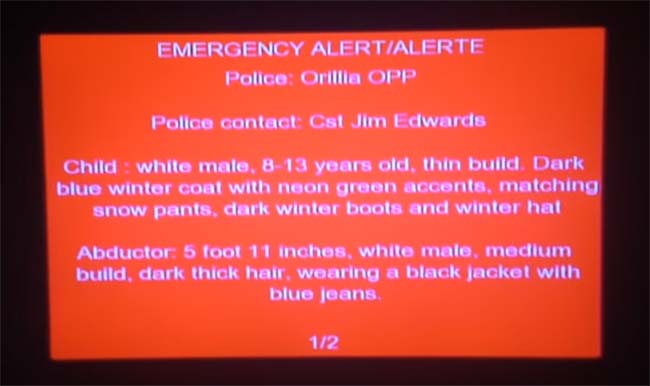Did the OPP overreact by sending out a red alert Sunday night?
Posted March 7, 2016 1:40 pm.
Last Updated March 8, 2016 1:57 pm.
This article is more than 5 years old.
The red alert that blasted across television screens Sunday night was clearly effective, as the child in question was found just over an hour later.
But was it really necessary?
Just before 10 p.m. ET, television programming across Ontario was temporarily interrupted by the blaring alert of an emergency, along with information about a missing boy in Orillia. The alert happened at least one more time before the boy was found by his parents and the alert was called off just before 11 p.m.
But according to emergency preparedness expert Ted Heighington, the alert should not have interrupted your television show.
“The protocol was wrong last night,” he told News 880. “It should have been an Amber Alert. It should have started like that.”
According to Heighington, the alert should have been a muted alert with a crawl across the bottom of the screen, not a full red alert. He says a red alert “is normally reserved for mass evacuations, industrial accidents, bio-hazards or things involving communities as opposed to one person.”
Related stories:
Boy who was subject of Amber Alert never abducted, police say
OPP cancel amber alert after Orillia boy found safe and sound
According to a release from the OPP Orillia Detachment, officers did what they felt was right to find the child.
“I am disappointed with the numerous calls and social media postings that have expressed anger and frustration with the personal inconvenience caused by the NAAD system messages,” said Detachment Commander Insp. Pat Morris.
“While I will apologize for any inconvenience this may have caused, we won’t apologize for using all of the tools available to us to find a missing child.”
Also at question is whether the incident even warranted an Amber Alert.
According to police reports, the first mention of a child abduction occurred at around 6 p.m., some four hours before the alert was dispatched. It involved a report by two witnesses that saw a boy with an adult male in a minivan. Police issued the alert just before 10 p.m. without knowing the boy’s name or age, just a description provided by witnesses.
“Child: white male 8-13 years old, thin build,” the alert read. “Dark blue winter coat with neon green accents, matching snow pants, dark winter boots and winter hat.”
Following the Tori Stafford case of 2009, the OPP changed the rules for issuing an alert from having to confirm an abduction or threat of harm to just believing that there may have been an abduction. And they issue Amber Alerts when they believe an immediate broadcast alert will help in locating the child.
In this case, the OPP clearly believed the child had been abducted and was at risk of harm.
However, OPP officers confirmed soon after the boy was found that he had never been abducted. His parents found him and said he had just run away from home.
“The criteria for an amber alert is discretionary,” Heighington said. “The criteria is not yet rigid, it’s still forming. It’s up to the discretion of federal and provincial military police authorities.”
“As police, we were concerned and public safety is our top priority,” Morris said. “Time is never on our side in matters of this nature – and with time comes an expanding geography of concern.”











